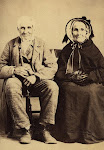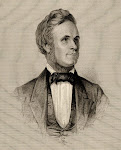Soon after his father took land in Woodruff, Joseph gave up his business in Salt Lake City and prepared to join the family, though not before he met and married Ann Lydia West in May of 1873. He had been involved in several building projects in Salt Lake and Ogden, including the remodeling of the Salt Lake Theater.
The theater had been the gem of Salt Lake society since it was built with inspiration and money provided by Brigham Young in 1861. Dedicated in 1862, it had a capacity to seat 1,500 and provided entertainment to many through the years. But with increasing influence from outside entertainment and a desire to divest himself of controversy, Brigham Young sold the theater in 1873. Immediately the newly formed Salt Lake Theater Corporation began remodeling to bring the image of thee theater more in line with that of well-known theaters in the east. Chairs were upholstered, the balconies remodeled, new balcony boxes built, carpeting installed, the stage lowered, and the whole interior was made plush and elaborate. The new owners boasted that it would be “one of the first class theaters of the continent, in fact in general internal appearances and comfort, the new house will greatly resemble “Noblo’s” of New York.
It was expected that this interior facelift would be done during the Spring and Summer so the theater would be re-opened for the fall season. Joseph helped complete the project, contributing to the beauty of the details with his ability to think out a project. The family remembers that in discussing how to create some of the decorative effects found in fine theaters of the East, it was Joseph who came up with a new way to accomplish it. Although no records exist of thoise who did the work on the theater that summer, we know that the ornate top plates and decorations were created by Joseph’s ingenuity. He boiling horse and cow hides to extract the glue, combined it with clay or quick setting lime, and them poured it into a prepared forms. He was also a plasterer for the theater. Since the theater was the gem of Salt Lake for a total of 66 years, it seems his ideas were well conceived.
By the time Joseph arrived in Woodruff, James had been there for several months. But the first winter was enough for them. When James and Joseph found out that winter last nine months in Woodruff, that cattle freeze and grain and potatoes regularly are frost killed before they mature, they packed up and went back to Bountiful. During those first years in Woodruff, it seems more and ore people became a testament of a family’s endurance if they could make a living and be happy in Woodruff. James had gardening in his blood, and couldn’t endure the fact that the best crops in Woodruff are sagebrush and mosquitoes. He became a respected brick mason in Bountiful and was known as one of Bountiful’s leading gardeners. He and Alice died there, quite contented for many years provided his near and distant family with fruit and vegetables whenever they traveled from Woodruff to Salt Lake.
Joseph on the other hand, couldn’t be content in Bountiful wither. After three years he moved his family to Ogden and worked in the building trade until 1882. There he became an excellent brick maker, a trade he put to good use the rest of his life. In fact, one of the first things he did after learning that the brick making trade was to find a spot where he could begin making bricks himself. Joseph found that there was building going on everywhere in Utah. He could have worked anywhere; but he as time went on, apparently he began to long for his family.
Soon Joseph and Ann joined the family in Woodruff where he opened a blacksmith shop and in 1884 a brickyard which was about one-half mile east of town. This brick kiln turned out the thousands of bricks which went into the new Chapel, Bryon Sessions’ brick house, and later the school. It was Joseph who supervised the church building project, beginning on January 14, 1895 and completed August 1897.
Somehow Joseph had the energy to take on the contract to build the Woodruff School building on Main Street across from the church which was also being built. He agreed to finish the school in 250 days. It was a superhuman task to complete both projects at once. No doubt with the help of his productive family, Joseph became a powerful factor in the building up of Rich County.
There is one additional thing Joseph took on during this period, which almost boggles the mind. Perhaps his invertible productivity was due in part to his unflinching determination to serve the Lord wherever and whenever he was asked. Between the Courthouse project and the Church project he was called on a mission to the Sandwich Islands (Hawaii). As soon as he finished the last brick on the school he accepted another call to England. Before he was to leave, however, the mission call was changed by Byron Sessions who needed Joseph to help him colonize the Big Horn Country in Wyoming.
Joseph had already built the County Courthouse in Randolph. In May of 1888 the county accepted bids for the building of a new brick courthouse, and Joseph’s bid was accepted. In the period of only months Joseph completed the building, incorporation the changes of a higher foundation and also shutters in the bargain. He received $2,479.00 for his work, which was completed in November.
Likely because of his profile as a worker and a thinker, Joseph became County Surveyor, and began a project to survey the boundary of Rich County in 1897. Instructed to mark the boundary with cedar posts, Joseph worked on the project during his term in office, but it was no an undisputed boundary until 1952 when his nephew Joseph Fischer Neville was Rich Bounty Surveyor. Joseph Fisher Neville is the one who surveyed and plated into lots the cemetery while he was county surveyor in May 1911.
Subscribe to:
Post Comments (Atom)









2 comments:
It should be noted that the pioneers when arriving in America before leaving England had their original names - Born and registered and christened the surname STIFF. Neville never came into their names. One such person known as F&G No 46918216 EMAIL miczmail@yahoo.com Micky Cook Odenwalder has tried to manipulate history of this family and my relatives by removing information of there former life in England and their good name.
The family when arriving in Utah had changed their names to what you see today.
Her action as resulted in the LDS site removing myself from the site when trying to add information which she repeatedly removed.
Utah Cemeteries & Burials Program Manager: -
Usually name changes happened at the point of entry and they were haphazard at best. For pioneers that decided to change their name after arriving in Utah they just kind of did it without any process within the LDS church or legally. Utah started issuing birth and death certificates in 1905 at the state level. Prior to that only Salt Lake County kept vital records and I've noticed records where names were crossed out or additional names written on them to indicate original names and any changes.
William STIFF (1803-1880)
1 William STIFF, son of William STIFF and Ann NEVILLE.
Sp. Rachel JENNINGS.
1 Elizabeth Rose STIFF.
Sp. James SMITH.
2 Sarah STIFF.
Sp. Christopher HOPKINS.
3 Rachel STIFF.
Sp. William AKERS.
4 William * STIFF.
Sp. Elizabeth * FISHER.
5 Hannah STIFF.
Sp. John COX.
6 Charles STIFF.
Sp. Kazie Maria WYATT.
7 George STIFF.
Sp. Matilda EVERARD.
8 John STIFF.
Sp. Emma SPENCER.
Sp. Annie CLIFT.
9 James STIFF.
Sp. Alice Elizabeth WATSON.
10 Joseph STIFF.
Stephen Gr 2nd cousin 3 times removed husband.
Sp. Ann Lydia WEST, dau. of Charles Henry John WEST and Eliza DANGERFIELD.
Stephen Gr 2nd cousin 3 times removed.
Post a Comment